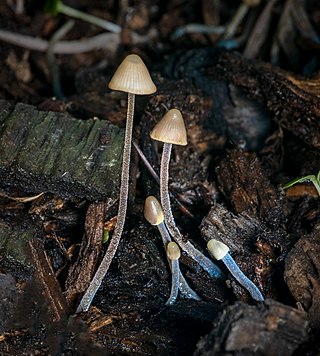
Mycena is a large genus of small saprotrophic mushrooms that are rarely more than a few centimeters in width. They are characterized by a white spore print, a small conical or bell-shaped cap, and a thin fragile stem. Most are grey or brown, but a few species have brighter colours. Most have a translucent and striate cap, which rarely has an incurved margin. The gills are attached and usually have cystidia. Some species, like Mycena haematopus, exude a latex when the stem is broken, and many species have a chlorine or radish-like odour.
Bruce Alexander Fuhrer OAM was an Australian botanist and photographer, specialising in cryptogams. His photographic collection of fungi numbers more than 3000 species.

The Fungi of Australia form an enormous and phenomenally diverse group, a huge range of freshwater, marine and terrestrial habitats with many ecological roles, for example as saprobes, parasites and mutualistic symbionts of algae, animals and plants, and as agents of biodeterioration. Where plants produce, and animals consume, the fungi recycle, and as such they ensure the sustainability of ecosystems.
Australohydnum is a genus of resupinate fungi in the family Phanerochaetaceae. The genus was circumscribed in 1978 by Swiss mycologist Walter Jülich with the Australian fungus Australohydnum griseofuscescens as the type species. A. dregeanum and A. castaneum were added to the genus in 1990 and 2006, respectively. Australohydnum griseofuscescens is now considered to be synonymous with Irpex vellereus.

Mycena galericulata is a mushroom species commonly known as the common bonnet, the toque mycena, the common mycena or the rosy-gill fairy helmet. The type species of the genus Mycena was first described scientifically in 1772, but was not considered a Mycena until 1821. It is quite variable in color, size, and shape, which makes it somewhat difficult to reliably identify in the field. The mushrooms have caps with distinct radial grooves, particularly at the margin. The cap's color varies from grayish brown to dark brown and the shape ranges from bell-like to bluntly conical to flattened with an umbo. The stem is hollow, white, tough and thin, without a ring and often roots deeply into the wood on which it grows. The gills are white to grayish or even pinkish when mature and are connected by distinct cross-veins. The caps can reach 4 cm (1.6 in) in diameter, and have a mealy odor and taste. The spore print is white and the gills are pink at maturity, which can lead to possible confusion with species of the genus Pluteus. M. galericulata mushrooms grow mostly in clusters on the well-decayed stumps of deciduous and coniferous trees from spring to autumn. The species can generally be considered inedible. It is common and widespread in the entire temperate zone of the Northern Hemisphere, but it has also been reported from Africa.

Mycena austrofilopes is a species of mushroom in the family Mycenaceae. It has been found growing in leaf litter under Eucalyptus trees in Victoria, Australia.
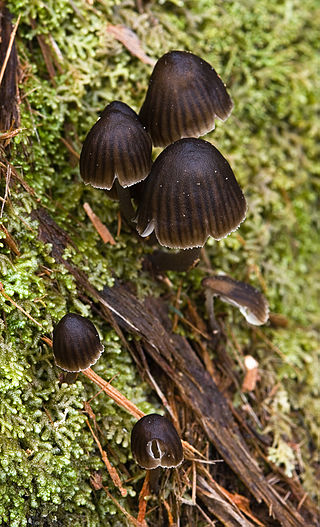
Mycena nargan, commonly known as the Nargan's bonnet, is a species of fungus in the family Mycenaceae, and the sole member of the section Nargan in the genus Mycena. Reported as a new species in 1995, it is known predominantly from Southern Australia. The saprobic fungus produces mushrooms that grow on well-decayed wood, often on the underside of wood lying in litter. The dark chestnut-coloured caps are covered with white, easily removed scales, and reach diameters of up to 2 cm (0.8 in) wide. The pale, slender stems are up to 5 cm (2.0 in) long and have white scales at the base. On the underside of the cap, the cream-coloured gills are widely spaced and bluntly attached to the stem. The edibility of the mushroom is unknown.
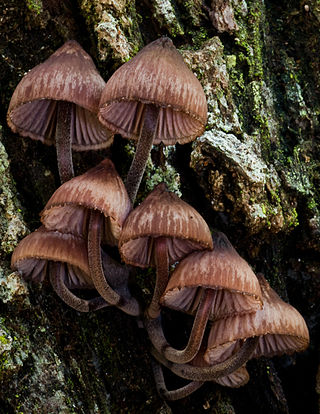
Mycena kuurkacea is a species of mushroom in the family Mycenaceae. It was first described in 2003 by Australian mycologist Cheryl A. Grgurinovic based on specimens found in New South Wales, Australia. Fruit bodies were found growing on leaf litter under Eucalyptus or on logs of Eucalyptus or Bedfordia salicina.

Mycena stylobates, commonly known as the bulbous bonnet, is a species of inedible mushroom in the family Mycenaceae. Found in North America and Europe, it produces small whitish to gray fruit bodies with bell-shaped caps that are up to 15 mm (0.6 in) in diameter. The distinguishing characteristic of the mushroom is the fragile stipe, which is seated on a flat disk marked with distinct grooves, and fringed with a row of bristles. The mushrooms grow in small troops on leaves and other debris of deciduous and coniferous trees. The mushroom's spores are white in deposit, smooth, and ellipsoid-shaped with dimensions of 6–10 by 3.5–4.5 μm. In the development of the fruit body, the preliminary stipe and cap structures appear at the same time within the primordium, and hyphae originating from the stipe form a cover over the developing structures. The mycelia of the mushroom is believed to have bioluminescent properties.

Roridomyces austrororidus, commonly known as the austro dripping bonnet, is a species of agaric fungus in the family Mycenaceae. Described as new to science in 1962 by American mycologist Rolf Singer, it is found in South America, New Zealand, and Australia, where it grows on rotting wood.
Hygrocybe kula is a mushroom of the waxcap genus Hygrocybe found only in Royal National Park and Lane Cove Bushland Park. It was described in 1997 by mycologist Cheryl Grgurinovic.

Mycena atrata is a species of mushroom in the family Mycenaceae. Found in Australia, it was first mentioned in the literature by mycologists Cheryl Grgurinovic and A.A. Holland in 1982, but this was invalid according to the rules of botanical nomenclature, as it lacked a formal description in Latin. In 2003, Grgurinovic formally described the species in her monograph on south-eastern Australian Mycena species.
Melanoleuca abutyracea is a species of fungus in the family Pluteaceae. Found in Australia, it was first described scientifically in 1931 by John Burton Cleland as a species of Collybia. Mycologist Cheryl Grgurinovic transferred it to Melanoleuca in 2002.
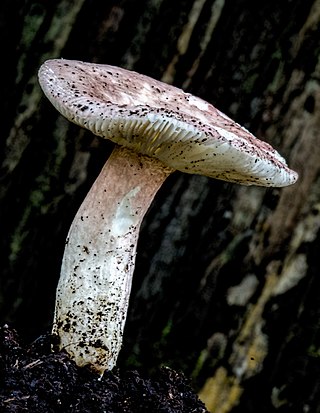
Russula lenkunya is a mushroom in the genus Russula. Found in South Australia, it was first described scientifically by mycologist Cheryl Grgurinovic in 1997.
Calostoma fuhreri is a species of gasteroid fungus in the family Sclerodermataceae. Found in Australia, the original specimens were collected by mycologist Bruce Fuhrer, for whom the species is named. Fruit bodies grow to 28 mm (1.1 in) tall, and comprise a pseudostipe that is 15–20 mm (0.6–0.8 in) long by 5–8 mm (0.2–0.3 in) thick and supports a roughly spherical peridium. Atop the peridium is an irregular stoma (opening) that is red on the inside. Inside the peridium is a white gleba that consists of spores, basidia, and broken hyphae. The spores are oblong to elliptical, hyaline (translucent), and typically measure 20–26 by 9–11 µm.
Hygrocybe fuhreri is a mushroom of the waxcap genus Hygrocybe. Described by mycologist Anthony M. Young in 2000, it is found in Australia, where it grows in moss and leaf litter in eucalypt woodland.

Entoloma moongum is a South Australian species of fungus in the large agaric genus Entoloma. It was described as new to science by mycologist Cheryl Grgurinovic; the original holotype collections were made from Belair National Park in the 1930s by John Burton Cleland, who erroneously referred the fungus to Leptonia lampropus.

Mycena subcaerulea is a species of mushroom-forming fungus in the family Mycenaceae. It produces small, thin-fleshed fruitbodies with pale bluish-green caps upon slender stipes. The centers of the caps are darker in colour than the margins, and the cap cuticle can be peeled off. The fungus was first described in 1873 as Agaricus subcaeruleus by American mycologist Charles Horton Peck. His original collections, found growing on the trunks of decaying beech trees, were made in woods of the Adirondack Mountains in Upstate New York. Pier Andrea Saccardo transferred the species to the genus Mycena in 1887.

Mycena albidocapillaris is a species of mushroom in the family Mycenaceae that is found in Australia. It was first described scientifically in 1933 by mycologist John Burton Cleland, who named it Mycena subcapillaris. The type collection was made in 1922 on Mount Lofty. It was later discovered that the name was invalid, as Paul Hennings use of that name in 1899 took precedence. Cheryl Grgurinovic and Tom May republished the species with the new replacement name Mycena albidocapillaris in 1997.
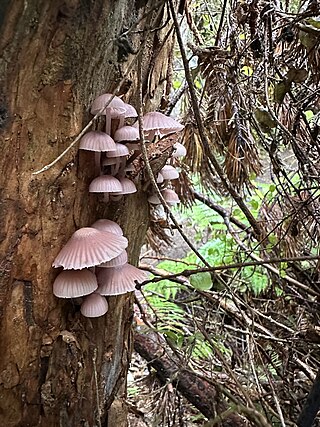
Mycena clarkeana is a species of bonnet fungus in the genus Mycena. Originally endemic to Australia, it can now be found in New Zealand also.













